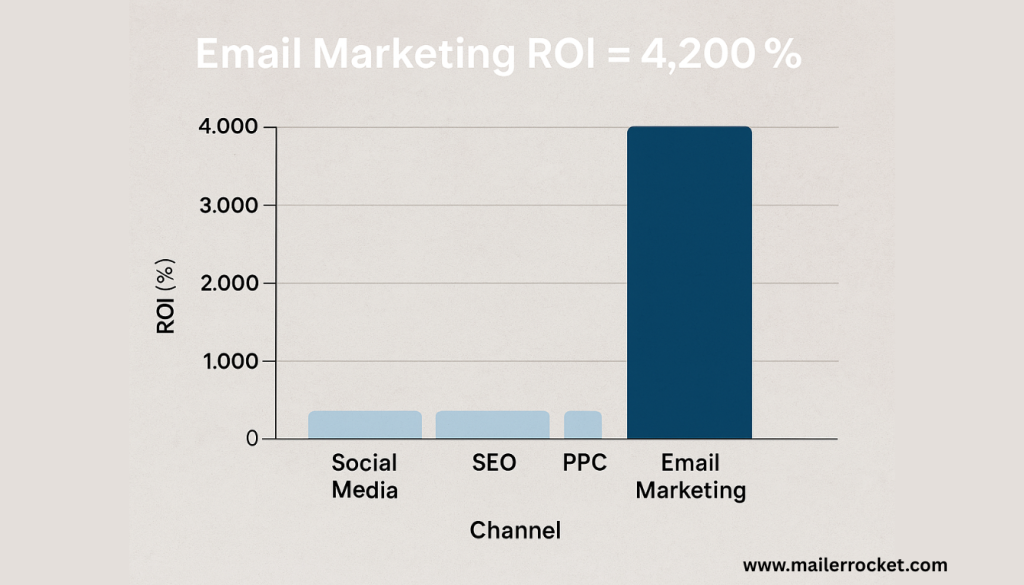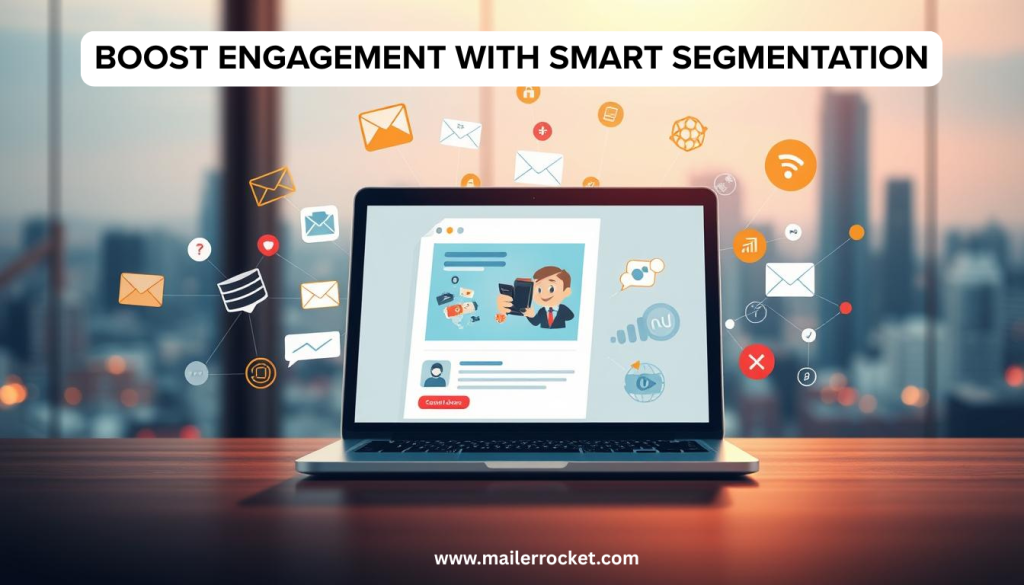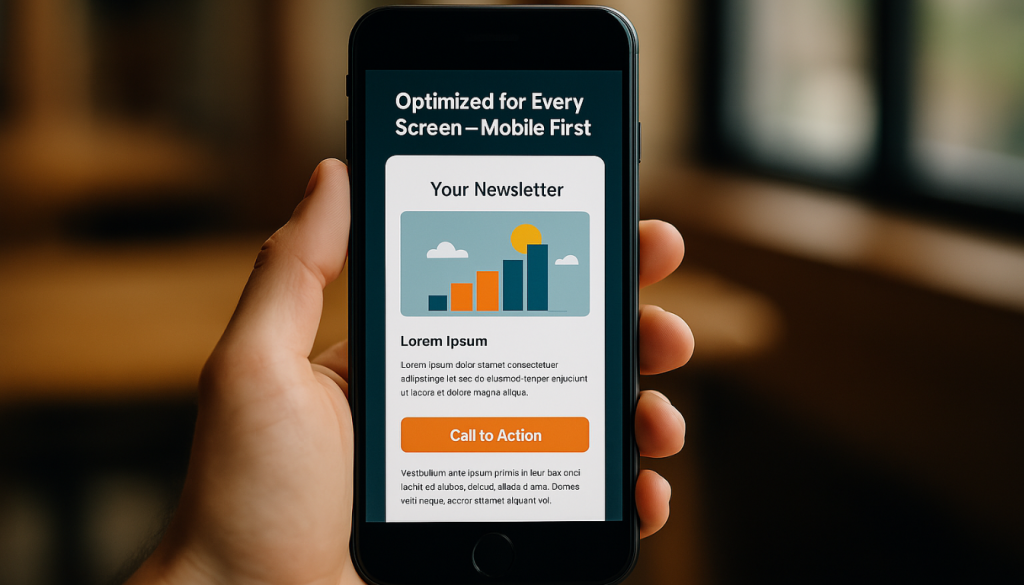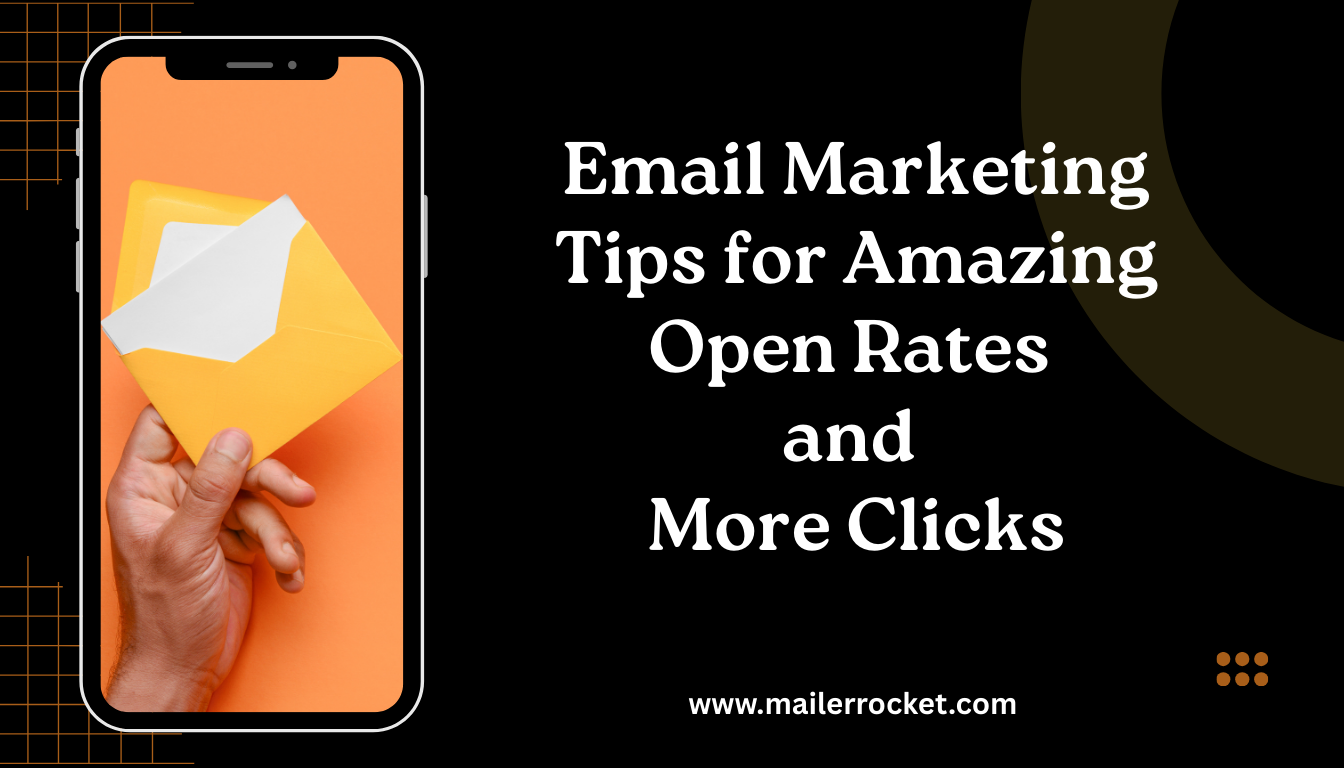In today’s digital landscape, having a robust email strategy is crucial for businesses to reach their audience effectively. With over 6.7 billion email accounts worldwide, as per the Radicati Group, it’s clear that email remains a vital channel for promoting content, products, and sales.
As someone who’s seen the impact of effective email campaigns, I can attest to the importance of crafting messages that resonate with your audience. By leveraging email marketing tips, businesses can significantly improve open rates and click-through rates, driving more conversions.
Key Takeaways
- Understanding your audience is key to a successful email strategy.
- Crafting compelling subject lines can significantly improve open rates.
- Personalization is crucial for increasing engagement.
- Segmenting your email list can lead to more targeted campaigns.
- Optimizing for mobile is essential for better click-through rates.
Unlock Your Best Campaign Yet with MailerRocket
Transform your email strategy with automation, personalization, and segmentation. Use MailerRocket to implement the exact tactics shared in this blog — and start seeing real open rate and CTR growth.
The State of Email Marketing in 2025
In the ever-evolving landscape of digital marketing, email remains a steadfast and effective channel. As a marketer, I’ve seen firsthand how email best practices can significantly impact the success of a campaign. With the right strategy, email marketing can yield impressive returns, making it a crucial component of any digital marketing mix.

Why Email Remains the ROI King in Digital Marketing
Email marketing continues to outshine many other digital marketing channels due to its ability to deliver high ROI. According to various studies, email marketing ROI can be as high as 4,200%, making it an attractive option for businesses looking to maximize their budget. This is largely due to the ability to target specific audiences and personalize messages, leading to higher engagement rates.
As I always say, “The key to unlocking the full potential of email marketing lies in understanding your audience and tailoring your messages accordingly.” By doing so, marketers can create campaigns that resonate with their subscribers, driving both opens and clicks.
Understanding the Critical Metrics: Open Rates and CTR
When it comes to email campaign optimization, two metrics stand out: open rates and click-through rates (CTR). Open rates indicate how many recipients opened your email, while CTR measures the percentage of those who clicked on a link within the email. These metrics are crucial for understanding the effectiveness of your email campaigns.
To improve these metrics, it’s essential to focus on crafting compelling subject lines and email content that resonates with your audience. By analyzing these metrics and adjusting your strategy accordingly, you can significantly enhance your email marketing performance.
Email Marketing Tips That Revolutionized My Results
As I reflect on my journey in email marketing, I’ve identified key strategies that significantly improved my campaign results. The right approach can make all the difference in the success of your email marketing efforts.
Throughout my experience, I’ve learned that crafting an effective email marketing strategy involves a combination of personalization, strategic planning, and a deep understanding of your audience.
My Personal Journey to Email Marketing Success
My journey into the world of email marketing was marked by experimentation and a willingness to learn from both successes and failures. I recall the early days when I was still figuring out the nuances of email subject lines and their impact on open rates. One of the key lessons I learned was the importance of personalization. Adding a personal touch, such as including the recipient’s first name in the subject line, significantly improved engagement.
Another crucial aspect was understanding the role of email conversion tips in optimizing my campaigns. By focusing on the elements that drive conversions, I was able to refine my strategy and achieve better results.
The Strategic Framework Behind My Campaigns
The strategic framework I’ve developed for my email marketing campaigns is centered around three core elements: segmentation, personalization, and timing. Segmentation allows me to tailor my messages to specific audience groups, increasing relevance and engagement. Personalization goes beyond just using the recipient’s name; it involves creating content that resonates with the audience’s interests and needs. Finally, timing is critical, as sending emails at the right moment can significantly impact open rates and conversions.

| Strategy | Description | Impact |
|---|---|---|
| Segmentation | Dividing the audience into targeted groups | Increased relevance and engagement |
| Personalization | Tailoring content to the audience’s needs | Improved open rates and conversions |
| Timing | Sending emails at optimal times | Enhanced campaign performance |
Setting Realistic Benchmarks for Your Industry
One of the challenges in email marketing is setting realistic benchmarks. Different industries have varying standards for open rates, click-through rates, and conversion rates. To set achievable goals, it’s essential to understand the benchmarks for your specific industry.
By analyzing industry reports and benchmarks, I can set realistic targets for my campaigns and continually assess and improve my strategies.
Tip 1: Craft Subject Lines That Demand Attention
In the world of email marketing, the subject line is your first and often only chance to grab the reader’s attention. With so many emails competing for a spot in the inbox, crafting a subject line that stands out is crucial for success.
The Psychology Behind High-Converting Subject Lines
Understanding the psychology behind what makes a subject line effective is key to crafting ones that convert. It’s not just about being clever or creative; it’s about understanding what drives the reader to open the email.
Emotional Triggers That Drive Opens
Emotional triggers play a significant role in getting emails opened. Using words or phrases that evoke emotions such as excitement, curiosity, or urgency can significantly increase open rates. For instance, using action-oriented language or creating a sense of limited-time opportunity can motivate readers to open the email.
Creating Curiosity Without Clickbait
While clickbait tactics might work in the short term, they can damage your credibility in the long run. Instead, focus on creating genuine curiosity by hinting at valuable content or insights within the email. This approach not only encourages opens but also builds trust with your audience.
My 5 Proven Subject Line Formulas
Over the years, I’ve developed and refined several subject line formulas that consistently perform well. These formulas are designed to be adaptable to various contexts and audiences.
- Personalized Offers: Using the recipient’s name or referencing their past interactions can make the email feel more personal.
- Urgency and Scarcity: Creating a sense of urgency or scarcity can prompt readers to act faster.
- Curiosity-Driven: Piquing the reader’s curiosity without resorting to clickbait can be effective.
- Benefit-Oriented: Clearly stating the benefits of opening the email can entice readers.
- Question-Based: Asking a relevant question can encourage opens by sparking curiosity.
A/B Testing Strategies for Continuous Improvement
A/B testing is crucial for understanding what works and what doesn’t in your subject lines. By continually testing different approaches, you can refine your strategy and improve your open rates over time.
When A/B testing subject lines, consider variables such as length, tone, personalization, and the use of emojis. Analyze the results to identify patterns and preferences among your audience.
Tip 2: Personalization Beyond First Names
To truly stand out in a crowded inbox, personalization beyond just using a recipient’s first name is crucial. In today’s competitive email marketing landscape, simply addressing someone by their name is no longer enough to capture their attention or drive meaningful engagement.
Advanced Behavioral Segmentation Techniques
Advanced behavioral segmentation is a powerful email automation technique that allows marketers to categorize their audience based on actions, preferences, and behaviors. This approach enables the creation of highly targeted campaigns that resonate with specific segments of your audience.
Tracking User Interactions for Better Targeting
By tracking how users interact with your emails, website, and previous campaigns, you can gain valuable insights into their preferences and behaviors. This data can be used to create segments based on engagement levels, purchase history, and other relevant criteria.
Purchase History-Based Personalization
Personalizing emails based on a customer’s purchase history is an effective email engagement strategy. For instance, you can recommend products or services that complement their previous purchases or offer loyalty rewards to repeat customers.
| Segmentation Criteria | Personalization Strategy | Expected Outcome |
|---|---|---|
| Purchase History | Recommend complementary products | Increased sales |
| Engagement Level | Tailor content based on interaction | Improved engagement |
| Demographic Data | Offer region-specific promotions | Higher conversion rates |
Creating Dynamic Content That Resonates
Dynamic content is a game-changer in email marketing, allowing you to create emails that adapt to the recipient’s preferences, behaviors, and other data points. By leveraging dynamic content, you can significantly enhance the relevance and appeal of your emails.
Tools and Platforms I Use for Hyper-Personalization
There are several tools and platforms that can help you achieve hyper-personalization in your email marketing campaigns. Some of my favorites include:
MailerRocket – For its powerful deliverability engine, real-time analytics, and intuitive automation that simplifies segmentation and drives better engagement. Perfect for scaling impactful campaigns effortlessly.
- Mailchimp for its advanced segmentation and automation features
- HubSpot for its comprehensive marketing, sales, and customer service platform
- Marketo for its sophisticated marketing automation capabilities
By combining these tools with advanced behavioral segmentation techniques and dynamic content, you can create highly personalized email campaigns that drive engagement and conversions.
Boost Email Conversions with MailerRocket’s Smart Tools
Craft subject lines that convert, design mobile-first emails, and automate your workflows. Everything you need to launch high-performing campaigns is waiting for you inside MailerRocket.
Tip 3: Perfect Your Email Timing and Frequency
To maximize the impact of your email marketing efforts, understanding the optimal timing and frequency is key. The timing of your emails can significantly influence open rates, click-through rates, and ultimately, conversions. In this section, we’ll explore how to determine the best sending times, adjust for different industries and time zones, and find the sweet spot for email frequency.
How I Determine Optimal Sending Times
Determining the optimal sending time involves a mix of data analysis, understanding your audience’s behavior, and sometimes, a bit of trial and error. For my campaigns, I start by analyzing the audience’s past engagement patterns.
Industry-Specific Timing Considerations
Different industries have different peak times. For instance, B2B emails tend to perform better on weekdays during work hours, while B2C emails might see higher engagement during evenings or weekends. Understanding your industry’s norms is crucial.
Here are some general guidelines for different industries:
- B2B: Tuesdays, Wednesdays, and Thursdays between 10 AM and 11 AM
- B2C: Weekends and evenings, particularly between 7 PM and 9 PM
- E-commerce: Fridays and Saturdays, during lunch breaks or early evenings
Time Zone Strategies for Global Audiences
When dealing with a global audience, timing becomes even more complex. I use segmentation to tailor the sending time to different time zones. This ensures that my emails are sent at an optimal time for each recipient, regardless of their geographical location.
Finding the Sweet Spot for Email Frequency
Email frequency is a delicate balance between staying top-of-mind and becoming a nuisance. To find this balance, I analyze engagement metrics and feedback from my audience.
Some key considerations include:
- Subscriber preferences: Give your audience the option to choose how often they want to receive emails from you.
- Content type: Newsletters, promotional emails, and automated sequences have different optimal frequencies.
- List segmentation: Different segments may have different tolerance levels for email frequency.
Seasonal Adjustments That Boost Performance
Seasonal adjustments can significantly impact email performance. For example, during holiday seasons, consumers are more likely to make purchases, making it an ideal time to increase email frequency for promotional campaigns.
Key seasonal considerations include:
- Holiday shopping seasons (Black Friday, Cyber Monday, Christmas)
- Summer sales or clearance events
- Back-to-school campaigns
Adjusting your email timing and frequency according to these seasonal trends can improve email open rates and increase email click-through rates.

Tip 4: Design Mobile-First Emails That Convert
As we dive into the world of email marketing, it’s clear that designing mobile-first emails is no longer a choice, but a necessity. With most emails being opened on mobile devices, a well-crafted mobile-first email strategy can significantly boost email engagement and drive conversions.
Essential Mobile Email Design Principles
When it comes to designing mobile-first emails, there are several key principles to keep in mind. First, responsive design is crucial, as it ensures that your email looks great on any device. This involves using flexible grids, images, and media queries to adapt to different screen sizes.
Another important aspect is clear typography. Choosing a clear, legible font is vital, as it directly impacts the readability of your email. I recommend using a standard font like Arial, Helvetica, or Open Sans, and ensuring that the font size is large enough to be easily readable on smaller screens.
Creating Scannable Content for On-the-Go Readers
In today’s fast-paced digital landscape, readers are often on-the-go, making it essential to create scannable content that can be quickly and easily consumed. To achieve this, use short paragraphs, bullet points, and headings to break up the content and make it more digestible.
Typography and Readability Best Practices
To ensure that your email content is readable on mobile devices, follow these best practices: use a font size of at least 14px for body text, and avoid using fonts that are too ornate or difficult to read. Additionally, use line spacing effectively to improve readability and make your content more scannable.
Image Optimization for Faster Loading
Optimizing images is critical for faster loading times and a better user experience. To achieve this, compress your images to reduce their file size, and use alt text to provide a clear description of the image. This not only improves accessibility but also ensures that your email content is still engaging even if images don’t load properly.
Call-to-Action Strategies That Drive Clicks
A well-designed call-to-action (CTA) is essential for driving clicks and conversions. To create an effective CTA, use action-oriented language, such as “Sign Up Now” or “Get Started Today.” Additionally, ensure that your CTA is prominently displayed and easily clickable on mobile devices.
By implementing these mobile-first email design strategies, you can significantly improve your email marketing performance and boost email engagement. Remember, the key is to create a seamless user experience that drives conversions and ultimately, revenue.
“The way to get started is to quit talking and begin doing.” – Walt Disney
This quote resonates with me because it highlights the importance of taking action and implementing effective strategies in email marketing. By following the tips outlined in this section, you can create mobile-first emails that drive real results.
Tip 5: Implement Strategic List Segmentation
By dividing your email list into targeted segments, you can significantly improve your campaign’s performance. This approach allows you to tailor your content and offers to specific groups, increasing the likelihood of engagement and conversion. In my experience, strategic list segmentation has been a crucial factor in enhancing email marketing effectiveness.
Email segmentation is more than just categorizing your subscribers; it’s about understanding their needs, behaviors, and preferences to deliver relevant content. This not only boosts engagement but also fosters a stronger connection with your audience.
My Customer Segmentation Framework
Over the years, I’ve developed a customer segmentation framework that has proven to be highly effective. This framework involves a combination of demographic, behavioral, and engagement-based segmentation techniques.
Demographic vs. Behavioral Segmentation
Demographic segmentation involves categorizing subscribers based on characteristics such as age, location, and job title. While this approach provides valuable insights, behavioral segmentation often yields more actionable data. By analyzing how subscribers interact with your content, you can create targeted campaigns that resonate with their interests.
For instance, you can segment your list based on purchase history, browsing behavior, or email engagement patterns. This allows you to craft messages that are more relevant to each group’s specific needs and preferences.
Engagement-Based List Management
Engagement-based list management is critical for maintaining a healthy email list. By monitoring subscriber engagement, you can identify inactive users and re-engage them through targeted campaigns or remove them to prevent negatively impacting your sender reputation.
Regularly cleaning your email list ensures that you’re only sending emails to subscribers who are genuinely interested in your content, thereby improving overall engagement and conversion rates.
Creating Targeted Campaigns for Different Segments
Crafting targeted campaigns for different segments requires a deep understanding of each group’s unique characteristics and preferences. By tailoring your content, offers, and messaging to resonate with each segment, you can significantly improve campaign performance.
For example, you can create special promotions for subscribers who have abandoned their carts or offer loyalty rewards to your most engaged customers. The key is to deliver content that is relevant and valuable to each segment.
Measuring the ROI of Your Segmentation Efforts
To determine the effectiveness of your segmentation efforts, it’s essential to measure the ROI of your campaigns. This involves tracking key metrics such as open rates, click-through rates, conversion rates, and revenue generated per segment.
| Segment | Open Rate | CTR | Conversion Rate | Revenue |
|---|---|---|---|---|
| Segment 1 | 25% | 5% | 2% | $1,000 |
| Segment 2 | 30% | 7% | 3% | $1,500 |
| Segment 3 | 20% | 4% | 1.5% | $800 |
By analyzing these metrics, you can refine your segmentation strategy, identify areas for improvement, and optimize your campaigns for better performance.
Tip 6: Leverage Automation for Consistent Results
Leveraging automation in email marketing has been a game-changer for my campaigns, allowing for consistent results without excessive manual effort. Automation enables marketers to send the right message at the right time, significantly improving engagement and conversion rates.
By automating routine emails, I can focus on crafting compelling content and strategies that drive real results. The key is to strike a balance between automation and personal touch, ensuring that my audience feels valued and understood.
Essential Automated Email Sequences in My Arsenal
Automated email sequences are crucial for maintaining consistent communication with my audience. Two of the most effective sequences I’ve implemented are welcome sequences and abandoned cart recovery campaigns.
Welcome Sequences That Convert
A well-crafted welcome sequence sets the tone for the subscriber’s journey. Mine includes a series of emails designed to introduce new subscribers to my brand, offer valuable content, and encourage engagement.
- The first email is sent immediately upon subscription, thanking the subscriber and providing a clear call-to-action (CTA).
- The second email follows a few days later, offering additional resources or exclusive content.
- The third email in the sequence aims to nurture the relationship by asking for feedback or encouraging social media engagement.
Abandoned Cart Recovery Campaigns
Abandoned cart recovery campaigns are another essential automated sequence. These emails target customers who have left items in their cart without completing the purchase, reminding them of their interest and encouraging them to return.
| Email Sequence | Timing | Content |
|---|---|---|
| 1st Email | Within 1 hour of cart abandonment | Reminder of the abandoned cart with a clear CTA |
| 2nd Email | 24 hours after the 1st email | Offer of a limited-time discount or promotion |
| 3rd Email | 3 days after the 2nd email | Final reminder with a sense of urgency (e.g., limited stock) |
Trigger-Based Emails That Engage and Convert
Trigger-based emails are highly effective because they are sent in response to specific actions or behaviors exhibited by the subscriber. These emails are timely, relevant, and often lead to higher engagement rates.
For instance, I use trigger-based emails to congratulate subscribers on their purchase or to re-engage inactive subscribers with personalized content. The key is to analyze subscriber behavior and respond appropriately.
Balancing Automation with Authentic Communication
While automation is powerful, it’s crucial to maintain a balance between automated emails and authentic, personal communication. Over-automating can lead to a lack of personal touch, potentially alienating subscribers.
To avoid this, I ensure that my automated emails are not only personalized but also infused with a human touch. This involves using segmentation to tailor messages, being transparent about the use of automation, and continually monitoring and adjusting my strategies based on subscriber feedback.
Power Up Your Strategy – Start with MailerRocket Today
Use the proven email marketing tips from this guide — and bring them to life with MailerRocket’s intelligent features. From trigger-based automation to segmentation, success starts here.
Conclusion: Your Roadmap to Email Marketing Success
By implementing the email marketing success tips outlined in this article, businesses can significantly enhance their email marketing performance. To get more email opens, it’s crucial to craft compelling subject lines, personalize content, and optimize email timing and frequency.
By leveraging strategic list segmentation, mobile-first design, and automation, marketers can drive more clicks and conversions. The key is to continually test and refine your approach to find what works best for your audience.
With these strategies in place, you’ll be well on your way to achieving email marketing success and driving meaningful results for your business. By focusing on the tactics that drive real engagement, you can maximize your ROI and take your email marketing to the next level.


